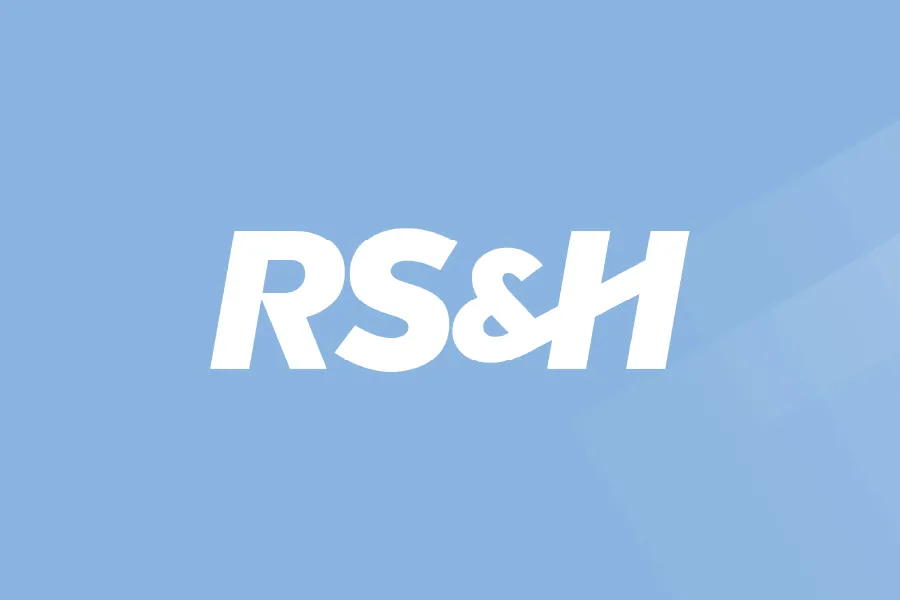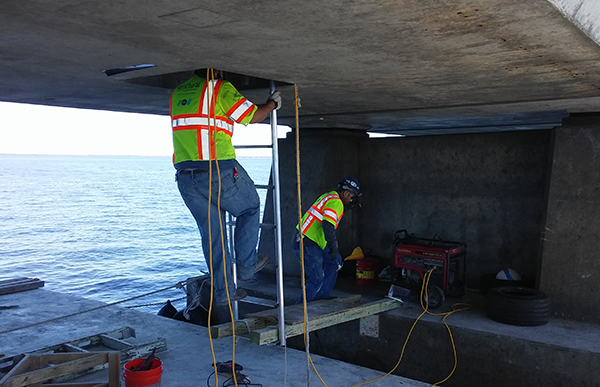Resourcefulness, Teamwork Reopen Bridge After Emergency Closure

In Okaloosa County in the Florida Panhandle, the Mid-Bay Bridge is a 3.6-mile, precast segmental crossing that connects Niceville to the white sand beaches of the Emerald Coast in Destin. About 22,000 residents, tourists, and beachgoers travel the bridge daily.
Without the Mid-Bay Bridge, these travelers could tack on about 40 minutes to their typical commute times. So, what happens when a bridge breaks?
FDOT District Three was forced to close the bridge after a routine inspection in January, and it was all hands on deck to repair the vital connection and reestablish a vital connection for frustrated commuters.
From Routine Inspection to Rapid Repair
RS&H was originally contracted by the Florida Department of Transportation (FDOT) in late 2018 to provide inspection services for the removal and replacement of one tendon in the bridge. In concrete structures, tendons are pre-stressed steel cables that snake within the spans to reinforce the bridge and support the load. For a bridge as long as the Mid-Bay, the tendons are critical to support the vehicle load.
In January, what was thought to be a routine FDOT inspection identified an additional seven tendons throughout the bridge that had severe corrosion. On January 8th, surprised commuters were met with variable message boards at each end of the bridge directing them to an alternate route.
The race began to repair and reopen the bridge to frustrated commuters and RS&H was contracted to manage the emergency repair. Additional inspections were conducted to confirm the condition of each tendon in question and determine the scope of the project.
Finding The Right Materials
The team determined that, in order to open the bridge and allow it to carry traffic while permanent repairs were performed, temporary 1 ¾ -inch post-tensioning (PT) bars had to be installed.
“Before we could do anything, we had to find the materials,” said RS&H project director Ben Searight, PE. “The project went from removing and replacing one tendon to installing seven spans worth of temporary PT bars. It wasn’t a common size that anyone had on hand.”
The team scoured the country for the right PT bars, eventually sourcing them from other project orders in Texas, with others overnighted from Chicago.
The first shipment of bars from Texas reached Okaloosa County on the morning of January 13th, and the remainder arrived from Chicago the following morning. The next 48 hours would be a whirlwind of obstacles, sweat and round-the-clock work to open the bridge.
Breaking Your Back
The PT bars weigh about 100 lbs. each and are about 10 feet long. The only way to get the materials through the box girder of the bridge was manual labor.
“It’s miserable, nasty work pulling those tendons out and getting them reinstalled,” said RS&H engineer Brian Wittenberg. “You’re working in an environment where you don’t have access to anything – there’s only an access hatch every half a mile – so you’re using carts, carrying materials, whatever you can to get the job done.”
“There were about 60 FDOT employees helping us carry and distribute these bars while we were prepping for installation,” Searight added. “The contractor and FDOT worked in three shifts to get the bars installed.”
By January 15th, the equipment had been moved more than 2 miles in the bridge – from span 29 to span 134. The bars had been coupled and installed through existing ducts in the pier diaphragms. The team was ready to begin post-tensioning the bars to complete the job.
Finishing The Job
Crews positioned a hydraulic jack to put 273,000 pounds of force on the bars, essentially stretching them out so they could be tightened and locked in place. When all goes well, the load is then transmitted to the concrete, providing additional capacity to the structure.
“We got the hydraulic jack in there, and when we pulled the first bar, we burst a seal on the ram,” Searight said. “We were dead in the water. Now we had to figure out where we could find another jack.”
So, in the early afternoon of Jan. 15, the team that had exhaustively prepped the bridge for repair was now scrambling to find a hydraulic jack so work could continue. That jack was found at the Durastress precast yard in Leesburg, Florida – nearly 400 miles and 6 hours away.
“I called another RS&H Sr. Project Engineer, Bill Downey, PE and said, ‘Hey, do you have someone who can drive to Leesburg and pick up this jack and drive it to Destin?’” Searight said. “I told Craig Parris, ‘Don’t stop, just get here as quickly as possible.’”
Parris, a Senior Inspector in Central Florida, dropped everything, secured the jack and made it to Destin around 9 p.m. that night. The team was finally ready to resume work around midnight, after having to modify the jack to meet their specific needs.
When the sun came up the next morning, the team was still working to finish stressing the bars.
The bridge reopened to joyful residents the morning of Jan. 16, just a week after it had been abruptly closed.
“It was an around-the-clock project,” said Wittenberg. “I’m not sure I’ve ever worked that many hours straight.”
RS&H has also managed construction of the permanent bridge repairs. This time around, the replacement tendons were constructed to the latest specifications, which have a much higher standard for corrosion protection. A specifically formulated thixotropic cable grout was used rather than the simple cement, water and expansive admixture grout that was originally used. The upgraded repairs are designed to prevent corroded tendons – which also caused the bridge to abruptly close in the early 2000s – from happening again.
